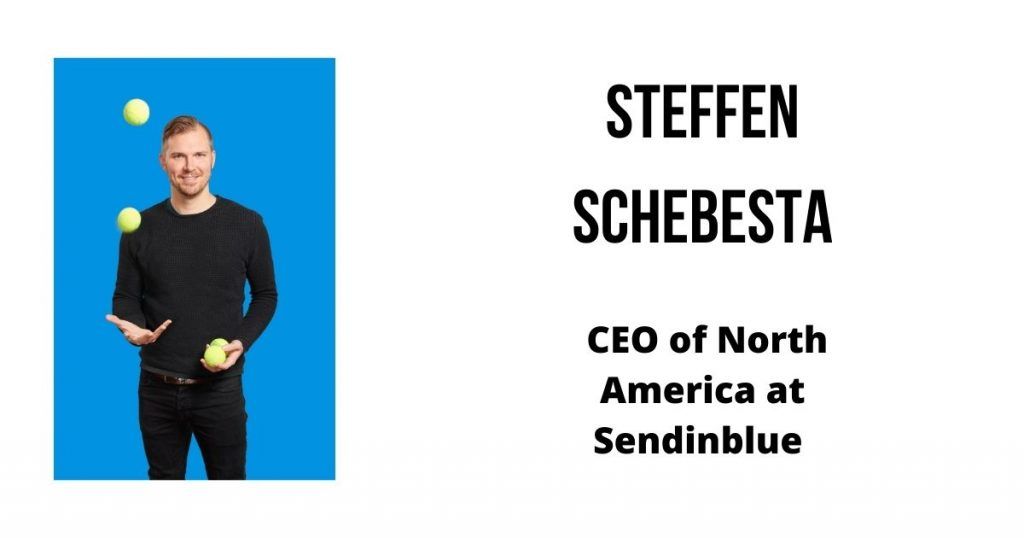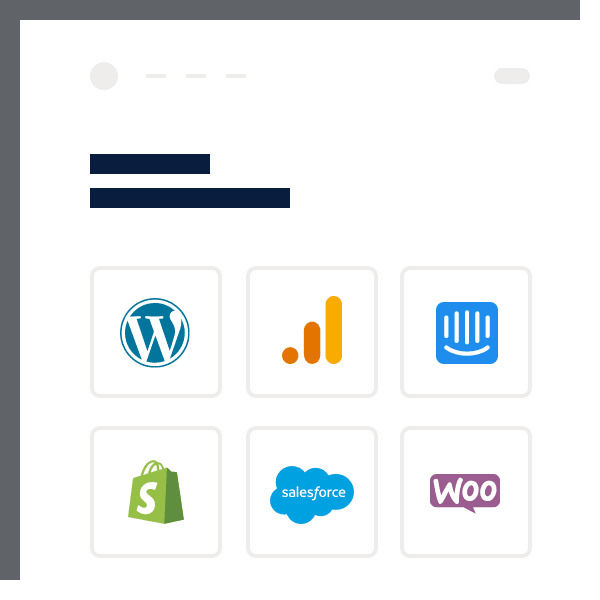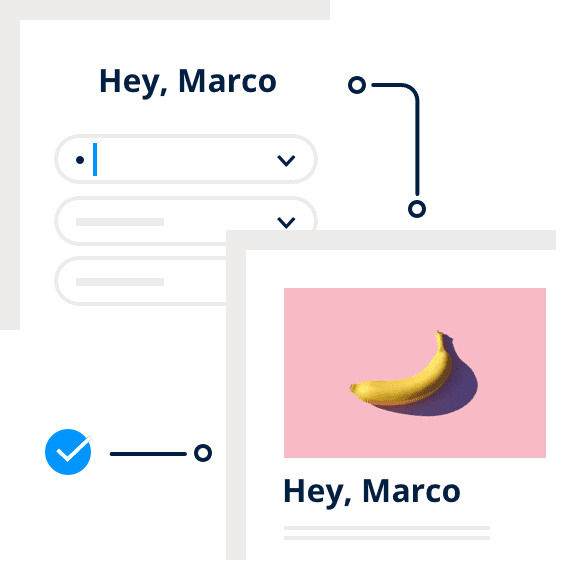When it comes to email marketing software, it’s a red ocean market with cut-throat competition. Be it bootstrapped companies like Mailchimp, or well-funded players such as Constant Contact, you’d definitely find an option that fits your needs. So how a company stands out in this segment? Well, that’s curiosity led us to talk to Steffen Schebesta, Sendinblue’s CEO of the North American market. It’s one of the most notable startups out of Europe that has gone global. So, we were of course, excited to understand the company’s evolution, target audience, and more.
PS: The interview has been edited for the sake of brevity.

Table of Contents
1) Before we begin talking about Sendinblue, can you share your journey into the world of SaaS?
He replied “the way we got started was through a customer project back in the day. I was still in my university, and I was 26-years old having a web agency that just did different projects. And then one of our customers approached us and he wanted us to create a small newsletter software for him. So we did that, and it was really a minor project. It was a shitty tool that we built back then. It was a desktop application that was really limited in its feature set. But at the same time, I heard that I had a lecture at the university and there was an entrepreneurship class. I had to find the topic for a business plan that we were writing there. And so, from that idea, building this pretty limited newsletter too, I thought maybe it makes sense to build something that would actually run in the browser. It won’t be limited to one customer who has to install it, and can be offered to anyone and runs on any OS as well.”
“That’s how the idea was born to build an email marketing software as a service. And that’s how we started writing the business plan. And then, in the business plan competition, we finished in the top 10 out of over 200 business plans, we decided to give it a go,” he added further.
2) Can you tell us about the reasons behind getting Newsletter2Go acquired by Sendinblue?
He mentioned that “as I said, we founded Newsletter2Go in 2011 and then we grew to one of the top email marketing software providers in the German-speaking markets in Germany, Austria, and Switzerland. We were pretty successful, and we had a compelling product. We had good customer service and we understood the market and the culture. So, we had a really good product-market fit in Germany. But over time we were at this point in 2018 when we were a company of about 70 employees. We had grown nicely, but the next step was to internationalize. And we had tried for a year and a half at this time, and it was not easy. In Europe itself, there are different countries, different cultures. In fact, in the major countries in Europe, like France and Italy, there were other local players that have been successful, and they built similar products to our products, but they had really understood the market better and had a better product-market fit. It was difficult for us to do that. At the same time, all the European smaller companies were competing with the big players from the US, such as MailChimp or Constant Contact. So long story short, we started thinking of joining forces with another European player.”
Explaining further, he said that “we talked to a lot of these providers from other European countries to see if we can merge the companies and be stronger together and build a better product and actually compete with the big players. And that’s how we ended up with Sendinblue in 2018.”
3) Could you tell us about your transition to become the CEO of North America at Sendinblue?

“After an acquisition, things change. And so, we started merging the products, brand, processes, and teams, and so on. So it was quite a big process. You can imagine that 70 people in Berlin. And then I think at this time there were 160 or so in the offices of Sendinblue. So it took a while. For me, it was also a startup in a transition phase – from being the CEO of Newsletter2Go to go to finding a new role. This ended up being expanding to the US or North America. It’s our fastest growing market, and now our number one market also in terms of new paying customers. So we’ve seen in the last one and a half years the North American market has been accelerating really quickly for us. So it made sense to open an office here in North America to build on this traction and continue our business development initiatives from here. And that’s what I’ve been doing. As a matter of fact, I moved here during the pandemic, which was not the easiest thing to do. And as you can imagine, um, a lot of impediments when you move during the pandemic, but it worked, worked out in the end. So the end of July, last year we opened our office in Toronto. It was me and another colleague from France who also moved to Toronto. So, we started as a team of two,” he stated.
He also told us that “now, we’re a small team of seven members. It’s more like a startup inside a scale-up, but we also have another office in North America, which is in Seattle, which has 35 employees. So now in the US or North American market, in total, we have 42 employees.”
4) Sendinblue started as a email marketing software, but today it seems like a full-fledged marketing platform. Could you tell what are key features offered by it?
Starting with the inception story of Sendinblue, Mr Schebesta said that “it was built inside of a web agency, and was actually started in India. So, one of the co-founders is Indian (Kapil Sharma), and the other one, Armand Thiberge. He’s, he’s the CEO of Sendinblue right now. And yes, we started as an email marketing software, and over time, adding more and more features and more and more channels such as SMS, and marketing automation.”
“We now have a landing page builder, live chat feature, inbox feature, CRM, and so on. And the strengths nowadays is really that you can combine these channels and it really makes it very powerful platform that is not only targeted at email marketers anymore, but to any online marketer. We’re expanding into the customer care and sales direction as well with our CRM and our inbox and chat feature. So, it’s really going to where our goal is to give small and medium businesses the tools that they need to compete with the big players. And we’re building an, an easy to use, all in one marketing software or even sales and customer care software that anybody can use. And that’s affordable too,” he explained further.
5) With so many features offered by Sendinblue, which of them is most used by your customers?
He revealed that “it’s still email marketing. Basically, this is where we came from, and it’s still email marketing that’s working incredibly well. If you invest $1 in email marketing on average, your return is $40 and it’s really good. You know email marketing has been declared dead so many times, but it’s really one of the most efficient online marketing channels out there, if not the most efficient one. It’s inexpensive, scalable, and platform agnostic. You don’t have to pay a Facebook or Google to reach to the audience. It’s also open source. Then there’s the fact that you can measure it well. Email marketing has also evolved over time. It’s not just an e-blast that you send out to your entire list. Maybe that’s how it was in the beginning, but nowadays you can target highly; you can have segments, automation workflows, and more. For instance, we have a feature called send at the best time, which has an AI algorithm in the background that sends the email to each recipient at the time where there’s a higher likelihood to open the email. These kinds of things get more sophisticated as well.”
Adding more context, he said “the next big thing is to combine all these and make it really omni-channel. This is already happening nowadays. If you have more than just email marketing and maybe you want to send text message notifications, or you want to use live chat on your website or have an inbox, and you want to combine that and make your campaign smarter and more personal life, because you can do it all on Sendinblue.“
6) How does Sendinblue stand out from the competition?

Steffen Schebesta noted that “since we’re building this all-in-one platform, we do have a lot of competition, whether it’s direct or indirect. Maybe somebody who’s only focused on a live chat feature, or somebody on e-commerce marketing. Our unique selling proposition, in the end, is a combination of a couple of things. We are aiming to offer a compelling, easy-to-use product at an affordable price to small and medium businesses. We hear a lot from our customers is that Sendinblue is really the best value for money I can get. That’s the number one thing that we hear over and over. For some customers, the reason to opt Sendinblue might be that we offer 24 x 7 support. We have customer care and in three different time zones, and in six different languages. So that might be something that attracts potential customers. In comparison, MailChimp only offers customer care in English and Spanish, and also, not on the phone. For some people, the reason might be that it’s super easy to integrate with your webshop or your CRM system that you already have running. So there’s really a lot of different reasons why people use Sendinblue. It’s also possible the combination of all of these which makes it stand out from the competition.”
6) How many customers do you have now? And what kind of industries are using Sendinblue the most?
Steffen told us that “Sendiblue has over 180,000 customers worldwide. We’re not focused on one industry and it’s for anybody who needs emails or online marketing channels. That said, we do serve a lot of e-commerce customers. We also have a lot of startups and small businesses. Basically, you can probably find customers from any industries over a hundred countries using Sendinblue.”
7) Could you shed a light on your marketing strategy to reach out to businesses?
“As we are a SaaS offering, we’re heavily focused on online marketing. So in terms of the acquisition, we use the most common online marketing channels such as Google Ads, Facebook, and more. Along with performance marketing, we do a lot of content marketing on our blog with partners. We also create videos and tutorials. And we recently launched Sendinblue Academy, where you can take email marketing classes for free. It takes about four hours to complete, and in the end, you get a really nice certificate that you can put on your CV. And certainly, you’d have learned something about email marketing at the same time, so that’s quite nice. We also do a lot of PR outreach. Having said that, the way our business works is through inbound. Since our typical customer is quite small, it’s not like we have a highly customized sales process in the background. It’s more like, customer sign up after finding us on Google most of the time, so we want to want to make sure that we’re ranking well. They sign up themselves and ideally, they book themselves without even contacting us and then use the software a lot of times without even being in touch with one, any, anybody from our team. So, it’s a self-service platform,” he replied.
8) Can you talk about your experience of building a global product and how one should think about it?
He shares “as I told about my experience of building Newsletter2Go, it’s evident that despite having a product-market fit, we weren’t big enough to really compete on a global level. When we joined forces with Sendinblue, this changed because that made us the European leader in our space right away. Over the next one, two years, we continued growing. Last year, in October, we raised $160million Series B, which was one of the biggest rounds in our industry ever. And only 10, or maybe 20 European companies raise over a 100million Euros per year. So, it was quite an exciting time. So it’s very interesting and challenging to build a global company.”
Related read: SaaS companies that got the funding
Speaking about the opportunities presented by the American market, he said “it’s also very exciting to cross the Atlantic, because usually it’s done the other way around. Most often than not, the big players come from the US to Europe, and they have really good traction in North America and they have a lot of capital behind them. And then, for them, it’s easier to conquer the European market. But we want to show that it’s also possible to do it in the opposite manner. So, we’re excited that we have the possibility to compete with the US players, backed by a great product, team, and our investors. We’ve seen great results so far in the last two years in the US. We’re growing at a really good rate and we’re proving our market position here.”
9) What’s next for Sendinblue?

Mr Schebesta said that “we’re a very product-centric company in general. Hence product comes first; we are continuing and will always continue to work on the product, making it as easy, as easy as possible to use for our customers, and making it affordable so that the small businesses can really take advantage of our software and be on an equal footing with, with the bigger players. So, we’ll be working on investing a lot of money, resources, and time working on new features. These include better e-commerce features, improving our livechat feature, our landing page builder, and so on. With more customers, we also work on our scalability, making sure that the platform runs smoothly, fast, and gets better in terms of UI and UX, all the time. So these are some of the focus points on the product side.”
He also added that “when it comes to the business side, I’m personally focused on the US expansion since it’s a big market for us. So, we’re focusing on that. We’re also looking into acquisitions. Last year, we acquired a company called MailClark in France who helped us build our inbox feature. And we’re always interested in innovative software companies that have our DNA and can help us improve our product or our reach. So that’s definitely possible that over the next year or two, there will be a couple of acquisitions.”
10) How has the ongoing pandemic affected Sendinblue – both in terms of businesses and no of users?
“For me, personally, it was a big change. And for, for Raffaello from the French team who moved here also of course, a big change. So COVID in general had a positive impact on Sendinblue. Of course, it’s difficult for a lot of businesses. And we were there to help these businesses who in a lot of cases are still offline or were offline when the pandemic hit,” he mentioned.
Illustrating with a real-life example, he shared “we had this farmer family in France who used to sell all the goods in a weekly market. So, it was a completely offline business. And when the pandemic hit, these markets had to close down. It was quite tough for them as they were the least digital people you could think of. What happened there is they created an account for Sendinblue, and they set up a small landing page. People were able to put their orders in, and they stayed in touch with the customer by sending out emails and notifications. Over the course of a couple of weeks, they were able to transition their business from completely offline to online. That was very impressive and showed the power of a tool like ours. Yes, it was forced in this case because there was really no other chance and a lot of other businesses had to do the same. But in the end, these farmers now are really in a better position than ever before. That’s because, they can reach new customers. It’s more like that their business models have become more resilient than they have ever been before. And in the end, they’re more successful. And the pandemic accelerated this transition to online. We’ve seen a lot of inflow of new customers in that time, so it accelerated our business overall. We also offered a free program for those who needed it. We had a small business, local business support program where you could apply, and you would get Sendinblue completely free. So, a couple of hundred businesses took advantage of that program. Overall, it’s been a difficult time for everyone, including the small businesses. So we’re happy that our software is able to help them. Of course, in a way, we benefited from it because our business grew in that time as well.“
11) What are your favorite SaaS products out there?
He stated that “one thing I use the most and day-to-day life is the whole G suite. I also like software like Trello to organize my work. From a user experience perspective, I love FullStory. I also enjoy using Notion, though it’s not purely SaaS. I also like Postman a lot, though it may not be considered fully as a SaaS offering as well.”






